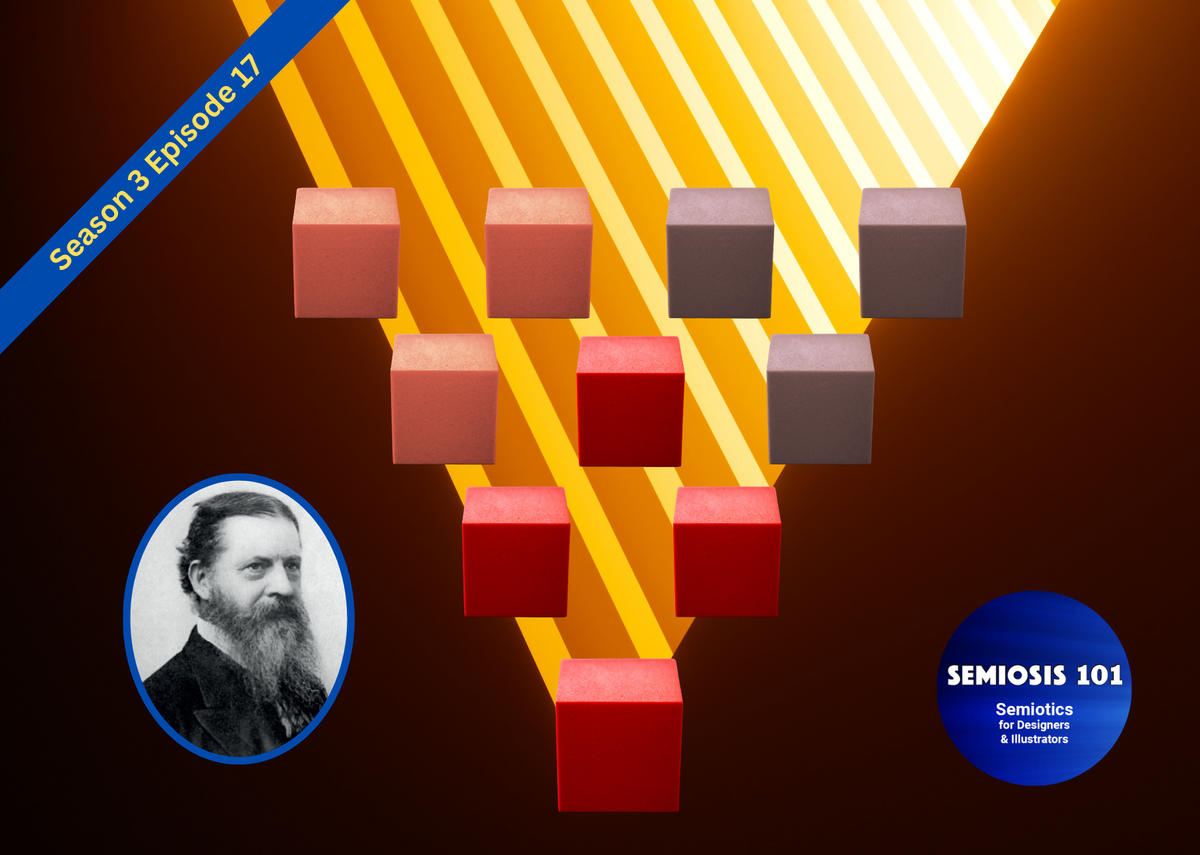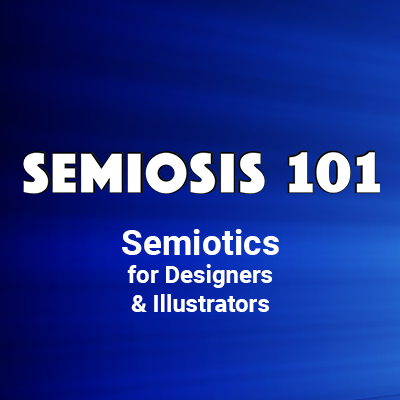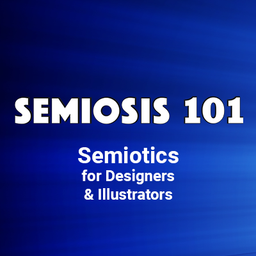Free Semiosis 101 Transcript 3.17:

TEN WAYS TO FRAME MEANING: Encoding Different Levels of Engagement
Hello readers.
In this free transcript for the episode published on Semiosis 101 on Weds 6 March 2024, we discuss how to use Peirce’s 10 semiotic sign classes to frame meaning for different purposes. We will do this through three lenses of Perception, Communication and Delivery.
Watch the free episode on YouTube for the full impact…
…and here is the episode’s transcript.
We now have reached a point in season three where we now have a deeper understanding of the powering of semiotic sign-action. So far, I have translated Peirce’s obtuse terminology into more designer-centric terms. This episode completes FIVE Semiosis 101 episodes on Peirce’s ten sign classes, which began as far back as season one. Now we are at the point of understanding to explore how to use these sign classes to frame meaning for different purposes. Hit subscribe to this YouTube channel, and I will explain…
Last episode we explored the idea of a sign-vehicle, a delivery method for the representation. I have described Peirce’s three levels of power in a sign class as comprising of Perception, Communication and Delivery. Each of the ten sign classes weave these three levels together in different assemblages of power, ranging from simple to complex. This is the crucial lens for creatives to approach the application of this knowledge.
So far, I have avoided Peirce’s obtuse terminology, but I will quickly reference it here to then jump into designer-centric terms. I will then be able to discuss how ten classes can help you to semiotically encode meaning.
Perception Power
Rhematic | Dicent | Argument
possible | suggested | resolved.
Communication Power
Iconic | Indexical | Symbolic
familiar | existent | proxy
Delivery Power
Qualisign | Sinsign | Legisign
instant | mediated | agreed
As I caveated last episode, my designer-centric terms are still evolving as analogues to Peirce’s. What I want to focus on now is your visual communication intent and then look at how the ten classes will help you. We will do this through three lenses of Perception, Communication or Delivery. Once we do that, you will see the opportunities of the ten sign classes.
Do not worry, this is not a memory test. There will not be an exam. This is about gaining knowledge to develop your own semiotic frame of mind (teaser alert to season four).
When visually communicating something to someone, the sign classes are adaptable to your needs. Let me quickly give an example. Your client wants you to provide a design or illustration outcome so their audience can BUY BAKED BEANS.
Remember much of Peirce’s theory of Semiosis is predicated on threes - triads. So, the semiotic Perception, Communication and Delivery of the visual communication have three degrees of intensity each. This means semiotically that there are nine variables on communicational intensity available to the creative, depending on what you need to visually communicate.
Ten sign classes providing nine levels of communicational intensity? Let us get a quick overview of what these intensity levels are, using our overtly consumerist example of BUY MORE BEANS. I will group the intensity variables under the lenses of Perception first, then Communication and Delivery. To make this relevant to creatives, I will frame each variable under a creative intent too. In other words… WHAT the client wants, then WHY the audience will be hooked, and only then HOW it works semiotically.
Okay.
Beginning with Perception, we will start with low semiotic intensity of a possibility of perceiving [Peirce’s Rheme]. Signs classes One, Two, Three, Five, Six and Eight start from this visual possibility.
What?
The client needs to sell tins of beans.
Why?
Does the audience know what a baked bean looks like? Or a tin can?
How?
A red oval-oid shape possibly shares a quality of a baked bean. A grey tube possibly has a look of a tin can. The audience at this stage has had their attention hooked by just perceiving possible shapes. The visual qualities of beans or tin can, can now build further meaning in the audience.
We now increase the semiotic intensity to visually suggest WHAT to perceive. [Peirce’s Dicent]. Signs classes Four, Seven and Nine start by suggesting X could be actually Z. This middle semiotic intensity level visually suggests more to perceive.
What?
The client needs to seduce audience desire with visually suggested beany deliciousness.
Why?
People need to eat. Beans need selling. People want to buy quality.
How?
By crafting the “beans” visual language the audience can become more certain that the visuals suggest delicious beans.
Finally, at a higher semiotic intensity Perception level [Peirce’s Argument], only sign class Ten works at this resolved perception level.
What?
The client needs the audience to only buy beans from them.
Why?
They are in business, obvs. They want to lead the market.
How?
The client’s branding resolves an unspoken agreement that a particular visual language used can only mean THAT client’s beans. This relies on the audience to socially (and semiotically) resolve that the visuals can only represent THIS brand’s beans.
Now moving onto Communication, we will once more begin with its lowest semiotic intensity, utilising visual familiarity [Peirce’s Iconic representation]. Sign Classes One, Two and Five utilise familiarity to begin the semiotic representation of the concept.
What?
The client needs the audience (customer) to know the sealed tin contains beans.
Why?
The opaque nature of a tin means that its label indicates what is inside. The typography can say BEANS but the eye needs seducing, rather than telling.
How?
Qualities of familiarity are utilised and nested in many ways to build not just meaning, but also desire to eat what is inside. Iconic elements such as succulent use of reds, multiple beans with glossy highlights, suggest home-cooked deliciousness.
We will now increase the semiotic intensity to move from familiar possibilities to representing existent things. This level utilises the familiar to interpret existent things [Peirce’s Indexical representation]. Sign Classes Three, Four, Six and Seven represents existent things, whether these are real or imaginative things.
What? and Why?
The client wants customers to cook and eat their beans at home.
How?
Label images often employ the suggestion of just cooked servings, on toasted bread, or on plates. Together with the nested Iconic images, these images represent existent things that can be found in any home.
Finally, at a higher semiotic intensity Communication level [Peirce’s Symbolic representation] there is a socio-cultural agreement that X is proxy for Z in this visual context. Sign Classes Eight, Nine and Ten utilise the power of visual meaning-bearing as an agreed proxy for something else. So how can one image can semiotically be a proxy for something else? Let us quickly explore representation as a proxy for something else.
What? and Why?
The client needs the customer to repeat buy only their beans, so they need to quickly identify the brand on a shelf.
How?
When in a socio-culturally way, certain colours (Iconic) and images (Iconic and Indexical), are semiotically perceived as a proxy for a product, then brands can build complex meaning from simple visual building blocks.
The last set of semiotic intensity levels focus on how the semiotic sign delivers its meaning. The low intensity level for semiotic delivery of meaning is instant [Peirce’s Qualisign]. Sign Class One is the only class that relies on an instant delivery that THIS quality X suggests Z.
What? and Why?
The client needs the customer to know there are beans in the tin, to sell beans. So at a semiotic instant delivery of meaning, how can this happen?
How?
The visual Iconic representations on the label instantly suggest “beans” on an immediate interpretive level. The middle intensity level for semiotic delivery of meaning is mediated. [Peirce’s Sinsign]. Sign Classes Two, Three and Four rely on a mediated delivery that in THIS context X proposes Z.
What? and Why?
The client wants their tinned beans to stand out from the competitors and be perceived as delicious.
How?
The semiotic sign-action between the label’s visual elements work together to mediate a proposal that these tinned beans are the best! The highest intensity level for semiotic delivery of meaning is agreement. [Peirce’s Legisign]. Sign Classes Five, Six, Seven, Eight, Nine and Ten rely on an agreement that delivered as X it MEANS Z. But an agreement??
What? and Why?
The client’s brand wants to be the market leader in tinned beans, so the customer buys more.
How?
The audience who shop for beans agree that when the client’s brand is recognised, it means quality BEANS! Semiosis helps to structure that branding.
In designer-centric terms we can explain Peirce’s ten signs classes in easier to understand terms.
|
ONE: |
possible > |
familiar > |
instant |
|
TWO: |
possible > |
familiar > |
mediated |
|
THREE: |
possible > |
existent > |
mediated |
|
FOUR: |
suggested > |
existent > |
mediated |
|
FIVE: |
possible > |
familiar > |
agreed |
|
SIX: |
possible > |
existent > |
agreed |
|
SEVEN: |
suggested > |
existent > |
agreed |
|
EIGHT: |
possible > |
proxy > |
agreed |
|
NINE: |
suggested > |
proxy > |
agreed |
|
TEN: |
resolved > |
proxy > |
agreed |
But… SO WHAT I hear you cry! Come back for the next two episodes to see how these sign classes work in actual design and illustration examples!
Semiosis 101 Semiotic Design Resources is a reader-supported publication. To receive exclusive posts and support my work, consider becoming a free or paid subscriber. Paid subscribers get name checked on all future Semiosis 101 YouTube episodes.
===Semiosis 101 Patreon Producer==============
Become a Semiosis 101 Patreon Producer and get a named producer credit on future video episodes, plus watch all new episodes months ahead of YouTube.
===Semiosis 101 Patreon Exclusives==============
Watch longer Patreon-exclusive Semiosis 101 episodes on applying Semiosis into design and illustration…
PATEXC001 How does semiotics work in illustration?





